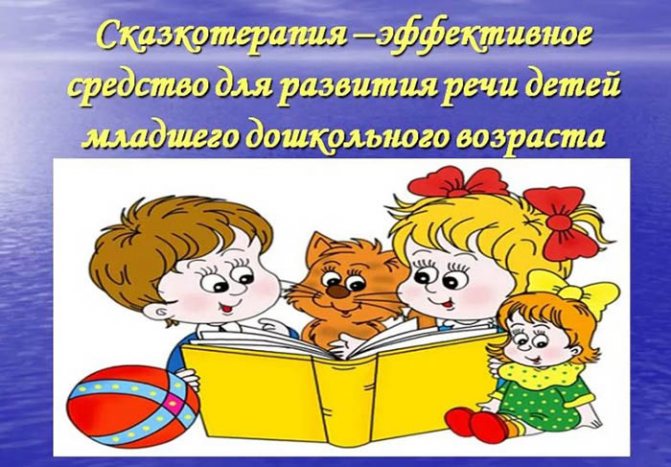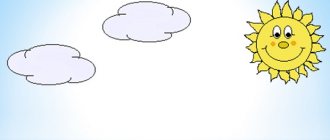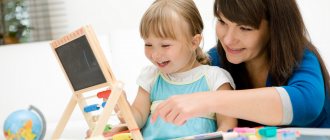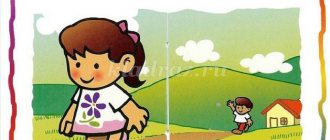Summary of a lesson on fairy tale therapy in the younger group
Methodological development for fairy tale therapy with children 2-3 years old. Topic: "Teremok".
Goal: To help children play together through a fairy tale and help each other in difficult situations. Objectives: 1. Develop children’s ability to listen carefully to a fairy tale.
2. Systematize children’s ability to answer questions after watching fairy tales. 3. Develop children's speech, help them use adjectives in speech when describing the hero of a fairy tale. 4. Cultivate friendly relations with each other. Progress of the lesson.
Educator: Guys, animals came to visit us, they are familiar to you, name them (children name a wolf, a hare, a fox, a mouse, a frog and a bear). What is a fox like in fairy tales? Children: Sly, red-haired, the bunny is afraid of her. Educator: That's right, guys. What kind of wolf? Children: Gray, angry. Educator: Is the mouse afraid of the wolf? Children: Yes, she is afraid, because she is kind, small, and the wolf is big. Educator: What kind of bear is in fairy tales? Children: He is very big, strong and club-footed. Educator: These are the different animals: big, small, kind, evil. But they came to us together, which means they know how to be friends. Let's look at a fairy tale about this. Sit comfortably and watch the story carefully. (Puppet theater show, fairy tale “Teremok”).
Well done guys, you watched the fairy tale very carefully.
And the bunny from the fairy tale wants to play with you, come to me and repeat the movements after the bunny. Game: “The gray bunny is sitting.” The little gray bunny sits and wiggles his ears. (makes ears on his head with his hands and moves them) Like this, like this And he moves his ears. (2 lines 2 times) It’s cold for the bunny to sit. We need to warm up our little paws. (claps his hands) Like this, like this We need to warm our paws.. (2 lines 2 times) It’s cold for the bunny to stand. The bunny needs to jump. (jumps) Like this, like this The bunny needs to jump. (2 times) Someone scared the bunny. The bunny jumped and ran away. Educator: Which animal was the first to find the tower? Children: Mouse. Educator: How did the animals help each other? Children: They cooked food together and swept the floor. Educator: Who broke the tower? Children: Bear, because he is the biggest. Educator: And then what did the animals do? Children: They built a new little house and all began to live in it together. Educator: You see how you can live together, help each other and not quarrel. Let's stand in a circle and hold hands. For the sun to smile, to try to warm you and me, we just need to become kinder and make peace sooner.
Hug each other and always play together.
We recommend watching:
Integrated lesson with children of the first group of early age Synopsis of educational activities in the 1st junior group on familiarization with the outside world. Visiting a fairy tale Technological map for organizing joint activities with children of the 2nd early group Synopsis of educational activities in the early age group with presentation
Similar articles:
Lesson notes for the 1st junior group of kindergarten. Introduction to clay
Lesson summary for an early age group. Getting to know the sun
Summary of a game development lesson in kindergarten in the second group of early age on the topic: Animals
Summary of a game lesson for children of the third year of life on the topic: Octopus
Summary of a game lesson for children of the third year of life on the topic: Clocks
MAGAZINE Preschooler.RF
Summary of developmental activities with elements of fairy tale therapy for children of the second junior groupCOMPLETED: Karpova Olga Viktorovna Teacher – psychologist
Explanatory note.
Education plays a leading role in the mental development of a child. Education of children should be imbued with concern for their full development. To do this, it is necessary to know how learning and development relate to each other, to take into account their relationship, carefully selecting the content and methods of teaching a child at different stages of his life. Mental development does not occur on its own, regardless of training. The leading role of training in development was substantiated by the Russian psychologist L. S. Vygotsky. Training, according to him, should take into account the achieved level of development, but not in order to stop there, but in order to understand where development is heading, what the next step should be. Education should always be ahead of mental development and lead it along.
The leading role of learning in mental development is manifested in the fact that a child, mastering new actions, first learns to perform them under the guidance and help of an adult, and then does it independently. According to L.S. Vygotsky, learning is only good when it creates a child’s zone of proximal development. Under such conditions, the child, learning with the help of an adult, successfully begins to do what he previously could not do on his own.
How to organize education for young children? Through a more accessible and pleasant form of communication for them, through play. The study of children's development shows that all mental processes develop more effectively in play than in other types of activities. Play is the activity most mastered by children. In it they draw models for solving new life problems that arise in knowledge and work.
In preschool age, play becomes the leading activity, but not because the modern child, as a rule, spends most of his time
spends in entertaining games - the game causes qualitative changes in the child’s psyche. Gaming activity influences the formation of arbitrariness of mental processes. Thus, in play, the child begins to develop voluntary attention and voluntary memory. When playing, children concentrate better and remember more. The conscious goal stands out to the child earlier and easier in the game. The very conditions of the game require the child to concentrate on the objects included in the game situation, on the content of the actions being played out and the plot. The game situation and actions in it have a constant influence on the development of the mental activity of a preschool child. Gradually, playful actions with objects are reduced, the child learns to think about objects and act with them mentally.
A fairy tale - what is it for a child? A fairy tale is the language of children. A fairy tale tells him about life in an accessible language, teaches him, illuminates the problems of good and evil, and shows him a way out of difficult situations. Fairy tales can easily be called one of the most effective means of raising and teaching a child. As mentioned above, children learn through play, and a fairy tale is the same game, only a game in the imagination. It is much easier to teach a child some skills during play, and it is also much easier to explain something to him using fairy tales. The role of a fairy tale can be considered in a broader aspect - with the help of a fairy tale it is possible to overcome the negative aspects of personality that are just beginning to form, also expand the child’s vocabulary, help learn how to properly build a dialogue with an interlocutor, develop logical coherent speech, among other things, while reading a fairy tale , the baby develops and consolidates the ability to ask questions. In addition to speech, other mental processes of the child can be developed by including fairy tales in activities with children.
Features of mental development of children from three to four years old.
The second youngest group is children from 3 to 4 years old. This age refers to the period designated in Russian psychology as preschool childhood (from 3 to 7 years). This period is preceded by the period of early childhood (from 1 to 3 years). It is necessary to take into account and trace the boundary between early and preschool age when developing a program of developmental work with children, and also not to forget about the individual characteristics of a particular child.
The end of early childhood ends with the three-year crisis. Its essence lies in the fact that the child develops an image of himself. The child moves from calling himself in the third person to calling himself in the first person, while striving to establish himself in different areas. L.S. Vygotsky emphasized both the negative and positive aspects of the crisis. Negative - the child’s negativism, stubbornness, obstinacy, self-will. Positive - separation from an adult, distinguishing oneself as an individual, manifestation of independence. The crisis of three years proceeds primarily as a crisis of social relationships between the child’s personality and the people around him. A child of the fourth year of life can separate the person performing the action from the action itself. Now the child performs the action, imitating the adult. But the child’s capabilities are still limited, and a contradiction arises between the desire to act “like an adult” and reality, which is resolved in the development of role-playing games.
Role-playing play becomes the leading activity in preschool age. The peculiarity of this game activity is that it highlights the role and game actions. A new form of communication with adults is emerging, which is characterized by their cooperation in cognitive activity. The new form of communication is non-situational and cognitive; it is based on the respectful attitude of an adult and his assessment.
Thinking gradually moves from visually effective to visually figurative. This is one of the main neoplasms of preschool age. In early preschool age, the development of perception continues. If by the age of 3 a child can point to 6 primary colors and 5 shapes, then by the age of 4 the child can relatively easily name the shapes and colors of surrounding objects.
With the development of play activities, children's imagination begins to improve. To develop it, you should use a wide variety of situations, for example, showing a toy (or picture), asking “Who is this?” Where did you come from? What did you do before?” .
Attention at this age is involuntary: a child can concentrate on one thing for no more than 10-15 minutes, which must be taken into account when organizing classes.
Child development is closely related to the development of visual arts. A feature of visual activity at this age is that the resulting image controls the design, which follows what the child depicts. Mastering constructive activities is also important for the development of the cognitive sphere. At this age, children can correlate such properties of objects as height, size, length.
In early preschool age, much attention should be paid to the development of children's speech. The sound side of speech is still imperfect. Its grammatical side is also being improved. If up to 2 years old nouns and verbs, after 2 years old adjectives, prepositions, conjunctions, and from 3 to 7 years old declension and conjugation of verbs. Vocabulary of about 1000 words. The question arises - why? The regulatory function of speech is formed, that is, the use of speech to regulate one’s own behavior.
At this age, the child is emotional: proud, touchy, joyful, sad, friendly, hostile, envious, capable of sympathy.
Taking into account the characteristics of this age period, it is important to use games and fairy tales with demonstration, so that there is a process of manipulating and performing actions with objects, toys (closer to 4 years, start working with images and symbols), use different intonations of the voice, play out all the actions, use more games to tactile perception.
Classes with children 3-4 years old should solve the following problems: awareness of emotional manifestations, reduction of impulsivity and development of self-regulation, development of children's play activities, development of observation, auditory and visual perception, development of speech and fine motor skills, development of a friendly attitude towards children. Games with children should be aimed not only at the development of individual mental processes, but aimed at a general, most comprehensive familiarization of the child with the world of objects, people, relationships, during which the gradual improvement and complication of all mental cognitive processes takes place.
We must remember about the problem of children’s adaptation to a child care institution at this age stage. Therefore, it is important to use more games for socialization and relieving psycho-muscular tension, and these are games, rhymes, pestles with stroking yourself, games for expressive movements and showing emotions, relaxation games.
Structure of activities with children.
Start of class.
Classes begin with the same song, which helps to switch attention to the lesson. For example, the song “The giraffe has spots, spots..” or “bus” “Aerobics for Kids” by Sergei and Ekaterina Zheleznov .
Welcome ritual.
Several options for the greeting ritual.
- Let's say "Hello" three times. All children in a circle (can be sitting, can be standing) hold hands. Let's say "Hello" quietly, say "Hello" louder "Hello" even louder .
- Hello, hello sunshine! (with each phrase shown).
We will sow the grain, Soon a sprout will grow, A bridge will be thrown, We will walk along the bridge, We will come to visit the sun.
3. "Bell" . Children take turns ringing the bell to the words of the teacher: “Tanya has a bell, a cheerful bell, dili-dili-don a cheerful bell .
A fairy tale or a game.
Tasks (modeling, appliqué, design), games on the theme of fairy tales, sketches on the ability to express emotions (children with a psychologist show various emotional states
Outdoor game. They are aimed at relieving psychomuscular tension, developing general motor skills, the ability to regulate one’s behavior according to the rules, getting to know one’s body, and learning to control it.
End of class ritual.
The ritual can consist of two parts: a relaxation exercise,
harmonization of the child’s internal state, and an exercise to unite children.
1. Laying down the doll (toy).
Children can sit on chairs, and if the room allows, they can sit or lie down on the carpet. To the music, children rock the toy, and after the end of the song, carefully put the toy back in place.
2. "Rays of Sunshine".
Children stand in a circle, stretch their hands forward and join them in the center of the circle.
Lesson duration is 25-30 minutes.
Options for developmental activities.
Lesson option using a fairy tale
Fairy tale "Puff"
We make a fairy tale for young children shorter than the real version, based on the characteristics of attention at a given age.
Figures of grandfather, grandmother, granddaughter, hedgehog, pictures of cabbage, carrots, turnips, cards of corresponding colors.
Once upon a time there lived a grandfather, grandmother and granddaughter Alyonka. And they had a vegetable garden. Cabbage, carrots, and yellow turnips grew in the garden. (the teacher shows the children pictures of vegetables and puts them in the right order, says to the children that cabbage is green, and puts a card with green under the picture, then the same with carrots and turnips). One day my grandfather wanted to eat turnips. He went out into the garden. He walks and walks, and it’s quiet in the garden, only the bees are buzzing and the mosquitoes are ringing (the children, together with the teacher, voice the bees and mosquitoes).
Grandfather passed a bed with cabbage, passed a bed with carrots. And here the turnip is growing. He just bent down to pull out a turnip, and someone from the garden hissed at him:
- Pssh-pp-y-hh! Pssh-pp-y-hh! (children repeat)
The grandfather got scared and ran away. He runs past a bed of carrots, past a bed of cabbage (pay attention to orientation in space: from left to right and back)… His heels are already sparkling. At home, his grandmother asks him:
- Well, grandfather, did you bring the turnip?
- Oh, grandma, there is such a terrible beast sitting there that I could barely carry my legs away!
- Yes, that’s enough, grandfather! I’ll go myself, I’ll probably bring a turnip...
And the grandmother went to the garden, and it was quiet in the garden, only the bees were buzzing and the mosquitoes were ringing. The grandmother walked and walked past a bed of cabbage, past a bed of carrots.
And here is the turnip. The grandmother bent down to pull out the turnip, and then someone hissed at her:
- Pssh-pp-y-hh! Pssh-pp-y-hh!
The grandmother got scared and ran away. She ran and ran past the carrots, ran past the cabbage. I barely made it home. She sat down on the bench, breathing heavily, couldn’t catch her breath.
- Oh, grandpa, you’re right! Someone is sitting there under a bush, so scary, and puffing. I barely lost my legs!
Granddaughter Alyonka looked at her grandparents, felt sorry for them and said:
- I'll bring a turnip!
Alyonka went to the garden. And in the garden it is quiet, only the bees are buzzing and the mosquitoes are ringing.
She walked and walked past a bed of cabbage, past a bed of carrots. And here is the turnip.
And just as she bent down to pull out the turnip, someone hissed from the garden bed:
- Pssh-pp-y-hh! Pssh-pp-y-hh!
Alyonka laughed and shouted in a ringing voice:
- It's me, Alyonka! Grandma and Grandpa came for a turnip.
And in the garden someone starts puffing again:
Pssh-pp-y-hh! Pssh-pp-y-hh!
Alyonka bent over the garden bed to see who was sitting there so scary, and suddenly she saw: some kind of prickly ball lying on the garden bed, its beady eyes sparkling and puffing:
- Pssh-pp-y-hh!
The girl laughed:
- Oh, you hedgehog, you prickly hedgehog! Did you scare your grandparents? Did you drive them home?
And the hedgehog extended his sharp muzzle upward and again:
- Pssh-pp-y-hh! Pssh-pp-y-hh!
Alyonushka pulled the turnip once, pulled another and a third, and pulled out the turnip. Yes, so big, round and yellow. Alyonka took the turnip, put the hedgehog in her apron, and went home. I ran past the carrots, I ran past the cabbage. And she immediately ran home. And her grandfather and grandmother came out to meet her. And they ask:
- Where is the turnip?
- And here’s a turnip for you!
Grandfather and grandmother were happy here:
- Well, we have a granddaughter! Well, Alyonushka! Well done girl! But what about this beast - the terrible Puff? Aren't you scared of him?
Here Alyonka opened her apron:
- And here’s Pykh!
The old men laughed:
Well done Alyonka! What a brave girl!
Tasks:
- Show the children pictures (or draw) emotions (sorrow-joy), and the children must choose the right picture that matches the end of the fairy tale.
- conduct a conversation on the topic “What grows in the garden?” With display of pictures and color cards. Ask the children to remember what vegetables grew in their grandfather’s garden in a fairy tale
- make hedgehogs out of plasticine (roll into a ball, needles - you can use toothpicks). Or use ready-made drawings to make needles from plasticine.
Offer to feed the hedgehogs. For example, apples. We make apples from plasticine and attach them to the hedgehogs’ backs.
Using the example of such a fairy tale and tasks, we develop speech, perception of color, attention, memory, expand knowledge about the environment (knowledge of vegetables, fruits), learn to distinguish emotions, teach courage, and develop fine motor skills.
Outdoor game. Where do hedgehogs live? In the forest. There are also snakes in the forest. Let's play snake. The snake will catch its tail. Children stand in a line, holding their shoulders. The first child is the head, the last is the tail of the snake. The head should reach and touch the tail. The snake's body is inseparable. Once the head grabs the tail, it becomes the tail and the children switch places.
Lesson option using a poem.
The teacher shows a bunny toy. Who came to visit us. The bunny greets the children, the children touch him, and the teacher asks: “What is he like?” (soft), “What kind of ears does the bunny have?” (long), “What does a bunny like to eat?” (carrots, cabbage) Let's choose from the cards those vegetables that he loves.
The teacher reads a poem:
“The mistress abandoned the bunny, the bunny was left in the rain. I couldn’t get off the bench. I was soaked to the skin.”
(A. Barto)
Tasks for expressive movements: the teacher, together with the children, shows with movements:
like a bunny is sad (lower your head, hunch your back, pressing your “paws” to your body, portray an unhappy expression on your face); like a bunny is cold (shrink your whole body, pretend to tremble); how you can call a bunny with your voice and movement (affectionately say: “come here” , while simultaneously swinging your hand “towards you” ); how you can help the bunny: warm it up (hug it carefully, wrap it in something warm, for example a doll blanket, and also depict how we warm the frozen paws of a bunny with our breath); feed (extend your hand to the bunny with an “open palm” , as if there is something tasty for the bunny in it); take pity (gently stroke his head, paws, back, while looking friendly into his eyes, you can at the same time speak tender words, pronouncing them with soft intonations).
The teacher encourages children to search for different options “solving” the task by asking the question: “How else can you help the bunny?”
Then the teacher suggests breaking into pairs, in each pair deciding who will be the “bunny” and who will feel sorry for him.
Fine motor skills task. Children make fur for a bunny out of cotton wool (tear off small pieces of cotton wool and glue them onto the drawing), on sheets with drawn bunnies (you can make carrots for the bunny).
Design assignment. We make a paper bunny applique from circles.
Outdoor game. Let's play fox and bunnies.
Conclusion
Correctly chosen games help children not only develop their cognitive processes, but also overcome behavioral deviations and prevent the manifestation of unfavorable forms of behavior. Any game, poem, even a seemingly boring task can be turned into a fairy tale, which will interest and captivate children. But there should always be visual positive accompaniment. In the classroom, you need to constantly distinguish the successes and achievements of each child, even the most insignificant ones. All sketches and movements must be performed with children, without making comments. It is better to approach the content of classes creatively, you can add something, change something, and also note the mood of the children, the problems of specific children.
Bibliography
- Alyabyeva E.A. Correctional and developmental classes for children of senior preschool age
- Veraksa N.E. Child development in preschool childhood
- Galanova T.V. Educational games for children under three years old
- Dubrovina I.V. Practical educational psychology
- Panfilova M.A. Communication play therapy
- Khukhlaeva O.V. The path to your Self
| Next > |
Fairytale therapy for children 2-3 years old
"Fairytale therapy with preschool children"
Lately, alarmed voices of teachers, public figures, and simply people who are not indifferent to the fate of our children have been increasingly heard saying that in modern socio-economic conditions it is necessary to look for new components in the system of educational work with preschoolers.
We, teachers, need to use both innovative approaches to education and domestic, time-tested educational traditions, for example, the technique of fairy tale therapy.
Fairytale therapy, like any other psychotherapy, is a form of knowledge and treatment of the soul.
Fairytale therapy explores the fairy tale as a form of existence and manifestation of mental processes and creates a fairy tale that has a beneficial effect on the psyche; focuses on the plot nature of psychological processes that are universal for people, regardless of culture and time.
The main goal of education is the formation of a harmoniously developed personality, ready for an independent path through life. The fairy tale contains moral values: good always triumphs over evil; laziness, greed, and sloppiness are condemned and ridiculed; teaches to treat good, skillful workers with respect; appreciates intelligence, resourcefulness, kindness. A fairy tale, especially a magical one, is a source that restores mental strength. The possibility of using magical power is a reminder that additional possibilities can be found to solve any problem. A fairy tale has the power of suggestion. Most often, we tell a fairy tale before bedtime, when the child is relaxed, and this is a favorable state for suggestion. Therefore, it is advisable to tell positive stories with a happy ending at night.
Each fairy tale has its own uniqueness.
Fairytale therapy is a process of searching for meaning, deciphering knowledge about the world and the system of relationships in it. It has a multifaceted impact on the personality of a preschooler. In fairytale therapy classes, children learn to create verbal images. During this activity, children’s vocabulary increases, the child’s inner world becomes more interesting and richer. In the process of fairy tale therapy, children's ideas about the same image expand, which in turn contributes to the development of mental abilities.
Empathy for a fairy-tale hero gives a child a sense of his own strength and significance. Since while listening to fairy tales, children are born not only positive, but also negative emotions, one of the most important goals of these activities is to teach the child to cope with his fears.
An important specific feature of education using fairy tale therapy methods is the possibility of using the emotional impact of works of art (which, in essence, fairy tales are) and creative activity on the child’s personality to enhance the educational effect. This effectiveness is enhanced by organizing an integrated approach to perception: reading a work of art with musical accompaniment, viewing illustrations, reading tales about nature in a picturesque place, etc.
The formation of moral qualities of an individual under the influence of a fairy tale is enhanced by the impact on various senses - hearing, vision, which ensures that children achieve a highly emotional state, which contributes to the implementation of educational tasks and the transition to self-education.
Joint listening to fairy tales and empathy helps to establish a moral climate in the children's group. Children, sharing their emotions, become more attentive to each other, more friendly, open, and empathetic. They start helping each other.
After reading a fairy tale, it is useful to talk with your child, asking the following questions:
- What is this fairy tale about?
— What qualities do the heroes have, who are they like?
Why does the hero do such things? Why is this necessary?
— How does the hero get out of a difficult situation? Does he cope on his own or does he use someone else's help?
— What do the hero’s actions bring to those around him – joy, grief? What is the relationship between the characters?
— What feelings does the fairy tale and its individual episodes evoke?
The artistic creativity of a child (his own fairy tales, drawings, crafts based on fairy tales, etc.) in the process of education with a fairy tale can be considered as one of the varieties of modeling reality, and the result of children's creativity - as a complex model of two objects - the phenomenon of reality and the personality of the author. At the same time, creative activity itself can be considered on two levels: the child’s activity directed outward (expression of one’s own emotions, feelings, ideas), and activity directed inward (self-knowledge, self-esteem, self-improvement). The following most important types of activities integrated into fairy tale therapy can be identified:
— creative – consists in the fact that the child creates something new to express the author’s intention;
- evaluative - manifests itself in the fact that the child in his works expresses his own value attitude towards the world, reflecting his own ideals, interests, needs, tastes;
- communicative - expressed in direct and indirect communication between the author and the recipient.
In practice, you can find several ways to work with fairy tales:
- Using a fairy tale as a metaphor. The text and images of the fairy tale evoke free associations that relate to a person’s personal psychological life. These metaphors and associations are then discussed.
- Drawing based on a fairy tale. free associations appear in the drawing, further work is done with graphic material.
- “Why did the hero do this?” Active work on the actions of the heroes.
It has been established that fairy tales of one's own composition provide a much more significant therapeutic effect. A fairy tale, as a rule, begins with a saying; children of older preschool age compose them themselves; younger preschoolers are offered ready-made options. When the saying is ready, we begin to come up with a hero. Children of middle preschool age love to make toys, little animals or little people heroes of their fairy tales.
With older preschoolers, you can take more complex images of the heroes of ancient fairy tales: prince, princess, fairy, Ivan the Fool, Marya the Beauty. In addition, children 6-7 years old love to compose characters that are similar to them.
At any age, children dress the characters to their liking, put them in a house that they would like to have themselves, and feed them their favorite treats.
In fairy tales, it is desirable to provide the hero with magical powers. She comes to him in the form of a wizard or is inherited, or can be acquired with a magical thing. The hero needs magical power to cope with another character in the fairy tale - the evil hero. Using magical power, goodness transforms the evil hero in humane ways, and he becomes pleasant, kind and loved by everyone.
Along with the magical change in the image that caused fear, the author or authors of this image themselves change. A happy ending to the fairy tale is guaranteed, and with it, the children's lives become fuller. It’s happier that it has a beneficial effect on the health of children. Of course, this process is slow, but it is one of the unique paths to health.
In addition, the fairy tales written by the children do not leave them. They stay with the children, continue to delight them and certainly help them in life.
Thus, the use of various ways of working with a fairy tale, taking into account the age and individual characteristics of preschoolers can help enhance the therapeutic effect of this technique.
So, the tasks of fairy tale therapy are to:
- Develop children's speech
- Identify and support creativity
- Reduce levels of anxiety and aggressiveness
- Develop natural communication abilities
- Develop the ability to overcome difficulties and fears
- Develop skills for constructive expression of emotions
The fairy tale about the Bunny who was offended by his mother is a therapeutic fairy tale. Fairytale therapy for children
Age: 4-9 years.
Focus: Conflict relationships with parents. Negative feelings (resentment, anger, etc.) towards parents. Inappropriate response to punishment and disapproval. Key phrase: “Mom doesn’t love me at all! If she loved me, she wouldn’t punish me.” The Bunny lived in a cozy house on the edge of the forest. One day he wanted to play with his friends in a sunny meadow. “Mom, can I go for a walk with my friends?” he asked. “Of course you can,” said mom, “just don’t be late for dinner.” When the cuckoo crows three times, come home, otherwise I will worry. “I’ll definitely come on time,” said the Bunny and ran for a walk. The sun was shining brightly in the forest clearing, and the animals were happily playing hide and seek, then tag, then leapfrog... The cuckoo crowed three times, and four, and five times. But the Bunny was so carried away by the game that he did not hear her. And only when evening came and the animals began to go home, the Bunny also happily ran home to his mother. But his mother was very angry with him for being late. She scolded the Bunny and forbade him to leave the house as punishment. The bunny was offended by his mother: he didn’t want to upset her, he just played with his friends and completely forgot about time, and he was so unfairly punished. “Mom doesn’t love me at all,” thought the Bunny. “If she loved me, she wouldn’t punish me.” And the Bunny ran away from home into the forest, found a hole and decided to stay there and live. At night it started to rain, it became cold and uncomfortable. The bunny felt very lonely, he wanted to go home to his mother, but he could not forgive her for punishing him. In the morning, the Bunny was awakened by the chatter of magpies who were sitting in a nearby tree. “Poor Hare,” said one magpie to another. “Yesterday her Little Hare ran away from home, she spent the whole night looking for him in the forest in the rain, and now she is seriously ill from grief and anxiety.” Hearing these words, the Bunny thought: “Since my mother is worried about me, it means that she probably loves me. She got sick because I ran away, and now she feels very bad. I have to forgive her and go home because I love her too.” And the Bunny rushed home. As soon as mom saw him, she immediately recovered, got out of bed and affectionately hugged her Little Bunny. “I’m so glad that you’re back, my dear,” said my mother. “I felt very bad without you, because I love you so much.” “I love you too, mommy,” said the Bunny. Since then, Bunny and his mother lived together and were not offended by each other. The bunny realized that his mother loves him and will always love him, no matter what happens.
Issues for discussion
Why was the Bunny offended by his mother? Would you be offended if you were him? Why did the Bunny return to his mother? What did the Bunny understand from this story?
Source
Fairytale therapy “Arrogant Bunny”
Fairytale therapy “ Arrogant Bunny ”
1. Help children imagine their own position in choosing the method of implementing actions, the image of a literary character.
2. Teach children to adequately convey their own affective states in movement, facial expressions, intonation (bragging, fear, joy, etc.)
.
3. Strengthen the ability to convey the rhythm of the characters’ movements ( the bunny is jumping , the fox is running, the bear is walking, etc.)
.
4. Develop the ability to voluntarily tense and relax muscles to remove bodily barriers (a bird putting out a fire, relaxing in the sun, etc.)
.
Definition of what it is
A method that uses fairy tale forms (works of art, for example) to develop a child’s speech is called fairy tale therapy. This method should not be underestimated, since for preschool children fairy tales are an important tool for increasing language abilities.

Works of art with magical plots help children develop their imagination. When children discuss fairy tales together with the teacher, the quality of their dialogical and monologue speech improves. The child’s creative potential develops and his vocabulary increases.
Using the example of fairy tale heroes, children experience various situations. Thus, an evaluative attitude towards good or evil develops. The child learns to empathize with the characters. A fairy tale gives impetus to the development of empathy.





